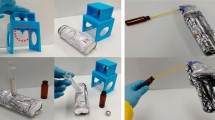Abstract
The characteristics of volatile organic compounds (VOCs) emitted from several consumer and commercial products (body wash, dishwashing detergent, air freshener, windshield washer fluid, lubricant, hair spray, and insecticide) were studied and compared. The spray products were found to emit the highest amount of VOCs (~96 wt%). In contrast, the body wash products showed the lowest VOC contents (~1.6 wt%). In the spray products, 21.6–96.4 % of the VOCs were propane, iso-butane, and n-butane, which are the components of liquefied petroleum gas. Monoterpene (C10H16) was the dominant component of the VOCs in the non-spray products (e.g., body wash, 53–88 %). In particular, methanol was present with the highest amount of VOCs in windshield washer fluid products. In terms of the number of carbon, the windshield washer fluids, lubricants, insecticides, and hair sprays comprised >95 % of the VOCs in the range C2–C5. The VOCs in the range C6–C10 were predominantly found in the body wash products. The dishwashing detergents and air fresheners contained diverse VOCs from C2 to C11. Besides comprising hazardous VOCs, VOCs from consumer products were also ozone precursors. The ozone formation potential of the consumer and commercial spray products was estimated to be higher than those of liquid and gel materials. In particular, the hair sprays showed the highest ozone formation potential.




Similar content being viewed by others
References
California Environmental Protection Agency-Cal. EPA (2005) CARB 310—determination of volatile organic compounds in consumer products and reactive organic compounds in aerosol coating products
Carter WPL (1994) Development of ozone reactivity scales for volatile organic compounds. J Air Waste Manag 44:881–899
Carter WPL (2013) Estimation of ozone reactivities for volatile organic compound speciation profiles in the Speciate 4.2 Database. Center for Environmental Research and Technology, University of California, USA
Chang CC, Chen TY, Lin CY, Yuan CS, Liu SC (2005) Effects of reactive hydrocarbons on ozone formation in southern Taiwan. Atmos Environ 39:2867–2878
Duan JC, Tan JH, Yang L, Wu S, Hao J (2008) Concentration, sources and ozone formation potential of volatile organic compounds (VOCs) during ozone episode in Beijing. Atmos Res 88:25–35
European Collaborative Action (ECA) (1997) Report No. 19. Total volatile organic compounds (TVOC) in indoor air quality investigations
ISO 16000-6 (2002) Indoor air—part 6: determination of volatile organic compounds in indoor and chamber air by active sampling on TENAX TA sorbent, thermal desorption and gas chromatography using MSD/FID
ISO 16000-9 (2004) Indoor air—part 9: determination of the emission of volatile organic compounds—emission test chamber method
Jo WK, Lee JH, Kim MK (2008) Head-space, small-chamber and in-vehicle tests for volatile organic compounds (VOCs) emitted from air fresheners for the Korean market. Chemosphere 70:1827–1834
Kim JC (2001) Factors controlling natural VOCs emission in a southeastern US pine forest. Atmos Environ 35:3279–3292
Kim YH, Kim KH, Szulejko JE, Bae MS, Brown RJC (2014) Experimental validation of an effective carbon number-based approach for the gas chromatography-mass spectrometry quantification of ‘Compounds lacking authentic standards or surrogates’. Anal Chim Acta 830:32–41
Kwon KD, Jo WK (2007) Indoor emission characteristics of liquid household products using purge - and - trap method. Environ Eng R 12:203–210
Kwon KW, Jo WK, Lim HJ, Jeong WS (2007) Characterization of emissions composition for selected household products available in Korea. J Hazard Mater 148:192–198
Kwon KD, Jo WK, Lim HJ, Jeong WS (2008) Volatile pollutants emitted from selected liquid household products. Environ Sci Pollut R 15:521–526
Latella A, Stani G, Cobelli L, Duane M, Junninen H, Astorga C, Larsen BR (2005) Semicontinuous GC analysis and receptor modeling for source apportionment of ozone precursor hydrocarbons in Bresso. Milan, J Chromatogr A 1071:29–39
Ling ZH, Guo H, Cheng HR, Yu YF (2011) Sources of ambient volatile organic compounds and their contributions to photochemical ozone formation at a site in the Pearl River Delta, southern China. Environ Pollut 159:2310–2319
Pohanish RP (2012) Sittig’s handbook of toxic and hazardous chemicals and carcinogens (sixth edition), Elsevier Inc., MA 02451, USA
Rahman MM, Kim KH (2014) Potential hazard of volatile organic compounds contained in household spray products. Atmos Environ 85:266–274
Rastogi SC, Heydorn C, Johansen JD, Basketter DA (2001) Fragrance chemicals in domestic and occupational products. Contact Dermatitis 45:221–225
Singer BC, Beverly K, Coleman BK, Destaillats H, Hodgson AT, Lunden MM, Weschler CJ, Nazaroff WW (2006) Indoor secondary pollutants from cleaning product and air freshener use in the presence of ozone. Atmos Environ 40:6696–6710
Steinemann AC (2009) Fragranced consumer products and undisclosed ingredients. Environ Impact Asses 29:32–38
Steinemann AC, MacGregor IC, Gordon SM, Gallagher LG, Davis AL, Ribeiro DS, Wallace LA (2011) Fragranced consumer products: chemicals emitted, ingredients unlisted. Environ Impact Asses 31:328–333
Szulejko JE, Kim KH (2014) Re-evaluation of effective carbon number (ECN) approach to predict response factors of ‘compounds lacking authentic standards or surrogates’ (CLASS) by thermal desorption analysis with GC-MS. Anal Chim Acta 851:14–22
Szulejko JE, Kim YH, Kim KH (2013) Method to predict gas chromatographic response factors for the trace-level analysis of volatile organic compounds based on the effective carbon number concept. J Sep Sci 36:3356–3365
United States Environmental Protection Agency (1999) Method TO-17. Determination volatile organic compounds in ambient air using active sampling onto sorbent tubes
United States Environmental Protection Agency (2011) SPECIATE 4.0
World Health Organization (2010) WHO guidelines for indoor air quality: selected pollutants
Acknowledgments
This study was supported by the Korea Ministry of Environment by “Eco-Innovation project (411-113-013)”.
Author information
Authors and Affiliations
Corresponding author
Additional information
Responsible editor: Constantini Samara
Electronic supplementary material
Below is the link to the electronic supplementary material.
ESM 1
(DOC 87 kb)
Rights and permissions
About this article
Cite this article
Dinh, TV., Kim, SY., Son, YS. et al. Emission characteristics of VOCs emitted from consumer and commercial products and their ozone formation potential. Environ Sci Pollut Res 22, 9345–9355 (2015). https://doi.org/10.1007/s11356-015-4092-8
Received:
Accepted:
Published:
Issue Date:
DOI: https://doi.org/10.1007/s11356-015-4092-8



